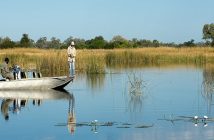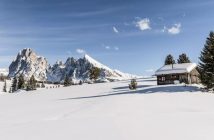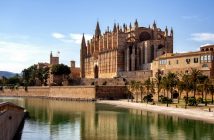There was a moment, as I drove around the Castello di Casole in Tuscany with Paulo the gamekeeper, when the penny dropped. During a visit to this glorious chunk of prime Tuscan real estate, in the last 24 hours I’d been battling with just that, this was ‘a prime chunk of real estate’. But, as we wound our way through the dense oak woodland, stopping every so often at the sight of a deer or for a glimpse of a hare, with Paolo filling me in on the necessity of hunting boars to control their population, words like ‘estate’, ‘resort’ and ‘development’ and all the associations that they conjure simply didn’t seem to do this justice.
As his 4×4 skirted the edge of the grounds and we crested a high point, we stopped to look over the 4,200 acre domain. As Paolo pointed out hilltop towns including, in the distance, the picture postcard San Gimignano, and undulating vineyards, olive groves and shimmering wheat fields rolled out before me, the proverbial coin hit the floor. This is not simply a resort, or a development or an estate in that sense of the word. As one of the largest privately-owned estates in Italy this is an ‘estate’ more in keeping with those of English landed gentry. And here was an opportunity to own a part of it.
Not for me, obviously. As a mere impoverished hack, this two-day taster of sumptuous Italian living was dangling in my vision like a 24-carat carrot of what I could have, firing my imagination, ambitions and envies simultaneously.
A drive of under an hour heading south from Florence, to the west of Siena, my first glance of Castello di Casole didn’t leap out at me. For one, the former castle sat atop a hill in what looked more like the Hampshire countryside than the rolling hills of Tuscany. But, rather than impose on the countryside, it seemed to fit within it. And turning into the understated entrance – I assumed the massive gates, stone lions and gun turrets would be going up in due course – we may as well have been continuing down a country lane. And that’s the point. This ‘development’ (for want of a better word) from purveyors of American luxury, Timbers Resorts, far from scooping up the land, bulldozing everything in sight and erecting gaudy gargantuan monoliths are, in fact, doing just the opposite.
When I’d heard the estate was previously owned by an Italian entrepreneur who had planned to build a series of bespoke homes (before becoming insolvent and being forced to sell), I sighed with disappointment on hearing that an American developer was taking over. That was it, then, another slice of the world’s rustic charm gone the way of some modern monstrosity. In fact, I was mistaken. The former owner had begun a plan of modernisation; it was Timbers who were insistent each property and the hotel retained its original Tuscan charm. Not to mention the small matter of Italian property law.
Originally under the ownership of 17th century Siena nobles, the Bargagli family, the estate was made up of smallholdings and farms producing olives, grapes and wheat until the 1960s, when it began to fall into disrepair. It’s the former farm buildings that formed the basis of the development with an extensive restoration and rebuilding programme turning these into luxury casali, Tuscan farmhouses, ranging from 4,000 to 7,000 square feet. What’s more, each is restored in the traditional Tuscan style using reclaimed materials, from the stone walls and barrel roof tiles to the ceiling beams. It’s not simply a matter of property law insisting each is in keeping with the landscape, it’s a conscious decision on the part of developers. And thank Da Vinci they did.
With such an extensive, dedicated approach it’s no wonder these houses are not simply up for sale. The preservation ethic goes on. Timbers run a ‘fractional ownership’ programme, giving people the opportunity to buy a casale, in whole or in part, giving people the opportunity to have, if you’ll pardon the cliche, their own slice of the Tuscan dream. But wait, I hear you say, partial ownership? That sounds suspiciously like…timeshare. And the cynic in me suspected as much.
This, however, is more than simply shared ownership. The estate is fully managed, with a list of amenities and services on offer that would put Mary Poppins to shame. Daily house-keeping doesn’t even scratch the surface. A bi-lingual personal ‘governante’ is on offer to assist with meals, pre-arrival grocery shopping, car and driver facilities and even a bellman service – I didn’t even know what a bellman service was but I felt I should have one.
That said, bespoke services and being waited on hand and foot are an indulgence I could live without. What made this more attractive than ever seeking a single holiday property abroad, however dutifully it was managed, was an idea they’ve introduced which is nothing short of inspired. The ‘reciprocity’ programme gives members an opportunity to use any of the properties on the estate. Before you balk at the idea of a total stranger moving into your pride and joy for a fortnight, consider this: timeshare is unmanaged, holiday lets are unpredictable and, perhaps most importantly, it eliminates the single most soul-destroying, pleasure-sapping principle of property ownership: home envy.
This was clearly evident as we took a tour of the estate to see some of the other properties. And I immediately felt that the one I was staying in was inadequate. Never mind the forno oven (a trifle, they’ve all got those), infinity pool (pah, so have most of them) or the firepit (it’s summer, who needs one), I could have moved into the one-room guest lodge alone at casale Vemignano. An oval bath sunk into Carrara marble faced a huge floor-to-ceiling semi-circular window with a view of the descending garden that opened up to the woodland and rolling hills of the estate beyond. Behind and a few stone steps above, brushing aside cream-coloured curtains: the bed chamber (that’s right, chamber). I wouldn’t even move into the villa. This house, alas, is already fully bought-up. Drat. Were it not for the reciprocity programme, that would have been the last time I could have marvelled at it. It still is the last time I could have marvelled at it, but that’s beside the point, were I an owner of one of these casali, Vermignano could still be mine.
It’s worth noting, however, quite how unique – not to mention how exquisitely rendered – each farmhouse is. Each is personalised with its own colour scheme, dressed with local Italian fabrics, top-of-the-range amenities such as Ballerini Gianfranco refrigerators, and furnished with antiques carefully purchased throughout Tuscany, from hand-painted chests to patio furniture. The nature of the design, too, is complementary throughout, even down to the Bizazza mosaic tiles in the swimming pools; chosen not only for their finish but in colours that don’t blot the landscape from the air, like the electric blue backyard pools that dapple the cityscapes of Miami or Los Angeles.
The development of Castello di Casole is still underway. Of the 28 casale planned for the estate, half are completed and are already sold – in fact, no sooner is another farmhouse finished, its shares are snapped up almost immediately. The fact that only 28 are planned for an estate spanning 4,200 acres is testament to the level of exclusivity to which Timbers are aiming. They could have got planning for more but the idea is that each nestles in its own vast acreage of land, that no one is over-looked but then neither is one isolated either, from one terrace you may see another property dotted on a distant hillside.
If nigh on half a million Euros is out of your budget, there is another option. The jewel in the crown is – rather, will be – the hotel itself. The Castello in question. The former residence of the Bagagli family and then to Italian movie stars in the 1960s – it was once home to filmmaker Luchino Visconti – the 41-suite boutique hotel is due to open in Spring 2012 and is intended as the social heart of the estate with fine-dining restaurant, pizzeria, wine bar and a state-of-the-art spa converted from the barrel-vaulted wine cellar of the former castle. And central to the hotel is the three-bedroom, three-bathroom Bagagli Penthouse; created from a meticulous restoration of the most important rooms of the castle it comprises two stories of wood-beamed ceilings, hand-plastered stone walls and a spacious private terrace with, understandably, the best views across the surrounding landscape.
As Paulo and I made our way back to my woefully inadequate 4-bedroom lodgings of Poggio alla Corona and I prepared myself for my third dip in the infinity pool over-looking the castle before tucking into yet another gruellingly-satisfying homemade meal by my personal chef, he explained that of the fifty-two game reserves in this region of Italy alone, Castello di Casole ranks in the top tier, to the extent that it has become a paragon of estate management that is influencing others in the area. The boars notwithstanding, there’s a lot you can do with 4,200 acres of land and its heritage of grape and olive growing continues with the estate producing its own wine – the Doci is excellent, incidentally – and olive oil. Very much a working farm in the classic tradition of Italy, it’s no wonder the estate is a recognised leader in organic agriculture and environmental best practices. Far from losing its roots, Castello di Casole is reviving them.
To have a fully-managed nature reserve, vineyard, olive grove in the grounds of one’s holiday home, well, there aren’t many who can say that.




